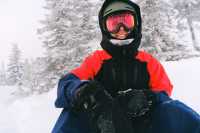
18 Dec Sledding: Head Injuries are a Serious Concern
MedicalResearch.com Interview with:

Rebecca McNally
Rebecca McAdams, MA, MPH
Senior research associate
Center for Injury Research and Policy
Nationwide Children’s Hospital
Columbus, OH
MedicalResearch.com: What is the background for this study?
Response: Sledding is a popular winter activity in communities across the country, but it may not be as risk-free as many people think.
MedicalResearch.com: What are the main findings?
Response: We found that 220,488 patients were treated in U.S. emergency departments for injuries related to sledding from 2008 through 2017. Nearly 70% of these patients were children age 19 years and younger. Compared to adults, children were almost seven times as likely to be treated in an emergency department for a sledding-related injury.
The majority of patients were injured as the result of a collision (63%). Collision injuries occurred when the patient made contact with an object in the environment (47%), when they hit the ground (16%), or when they ran into another person (10%) or sled (7%).
Head injuries are a serious concern during sledding. The head was the most frequently injured body part for children. In fact, nearly 82% of those who sustained an injury to the head were children. The type of sled can also impact the risk of head injury. Children injured while riding snow tubes and disks had a greater risk of sustaining a concussion or CHI than children who were riding sleds or toboggans. Researchers recommend wearing a helmet while sledding to reduce the risk and severity of head injuries.
While less frequent (3% of all cases), injuries occurring as a result of the sled being pulled by a motorized vehicle such as a car, ATV or snowmobile resulted in more serious injuries that required hospitalization (14%). This practice should be avoided.
 MedicalResearch.com: Is a bike helmet sufficient for protection during sledding or is ski helmet necessary?
MedicalResearch.com: Is a bike helmet sufficient for protection during sledding or is ski helmet necessary?
Response: We recommend children and adults wear a properly fitted snow sport helmet or bicycle helmet when sledding. Keep in mind that bicycle helmets may need to be adjusted to account for ear warmers or hats.
MedicalResearch.com: What should readers take away from your report?
Response: We recommend that parents and caregivers help children stay safer while sledding by following these tips:
- Wear a helmet: Make it a rule that everyone has to wear a helmet if they are going to sled. Properly fitted snow sport helmets or bicycle helmets are best.
- Pick your sled: Sleds that can be steered and have braking features may allow for more control than flat sheets, snow discs, tubes and toboggans. Also make sure to follow manufacturer guidelines for the number of passengers a sled can safely hold.
- Check the environment: A safe sledding environment should:
- Be free of obstacles (e.g., trees, rocks, light posts, walls, etc.).
- Have plenty of space at the end of the hill to allow the sled to safely slow down (avoid driveways or hills that end in a street, drop off, parking lot, or a body of water like a river or pond).
- Be free of motorized vehicles like ATVs, snowmobiles, cars, etc. Use of these types of vehicles to pull a sled can lead to serious injury and even death.
- Follow the rules: Always ride the sled while seated with your feet facing the bottom of the hill. Only ride during daylight hours. Teach children to roll off the sled if it is going too fast or is going to crash so they can avoid collisions.
- Stay for the fun: Having an adult present to check the environment for hazards and make sure kids are following safety guidelines while sledding can prevent injuries.
MedicalResearch.com: What recommendations do you have for future research as a result of this work?
Response: Continued and targeted efforts are needed to promote safe sledding practices and environments for children and adults.
I have no financial relationships or potential conflicts of interest relevant to this article to disclose.
Citation:
Evans KHC, McAdams RJ, Roberts KJ, McKenzie LB. Sledding-Related Injuries Among Children and Adults Treated in US Emergency Departments From 2008 to 2017. Clin J Sport Med. 2020 Dec 14. doi: 10.1097/JSM.0000000000000864. Epub ahead of print. PMID: 33323755.
JOIN OUR EMAIL LIST
[mailpoet_form id="5"]We respect your privacy and will never share your details.
[last-modified]
The information on MedicalResearch.com is provided for educational purposes only, and is in no way intended to diagnose, cure, or treat any medical or other condition. Always seek the advice of your physician or other qualified health and ask your doctor any questions you may have regarding a medical condition. In addition to all other limitations and disclaimers in this agreement, service provider and its third party providers disclaim any liability or loss in connection with the content provided on this website.
Last Updated on December 18, 2020 by Marie Benz MD FAAD
